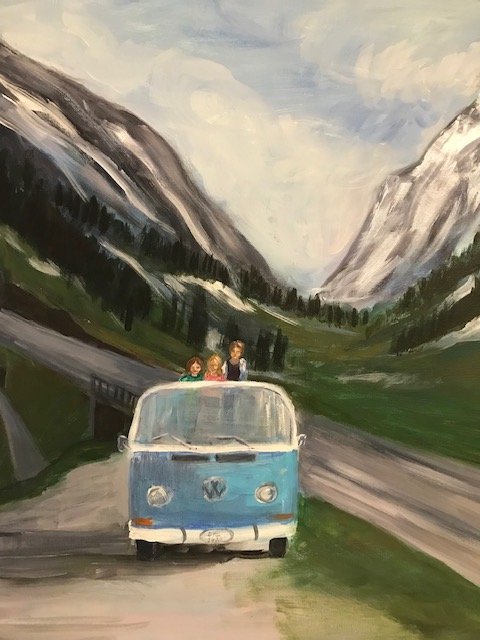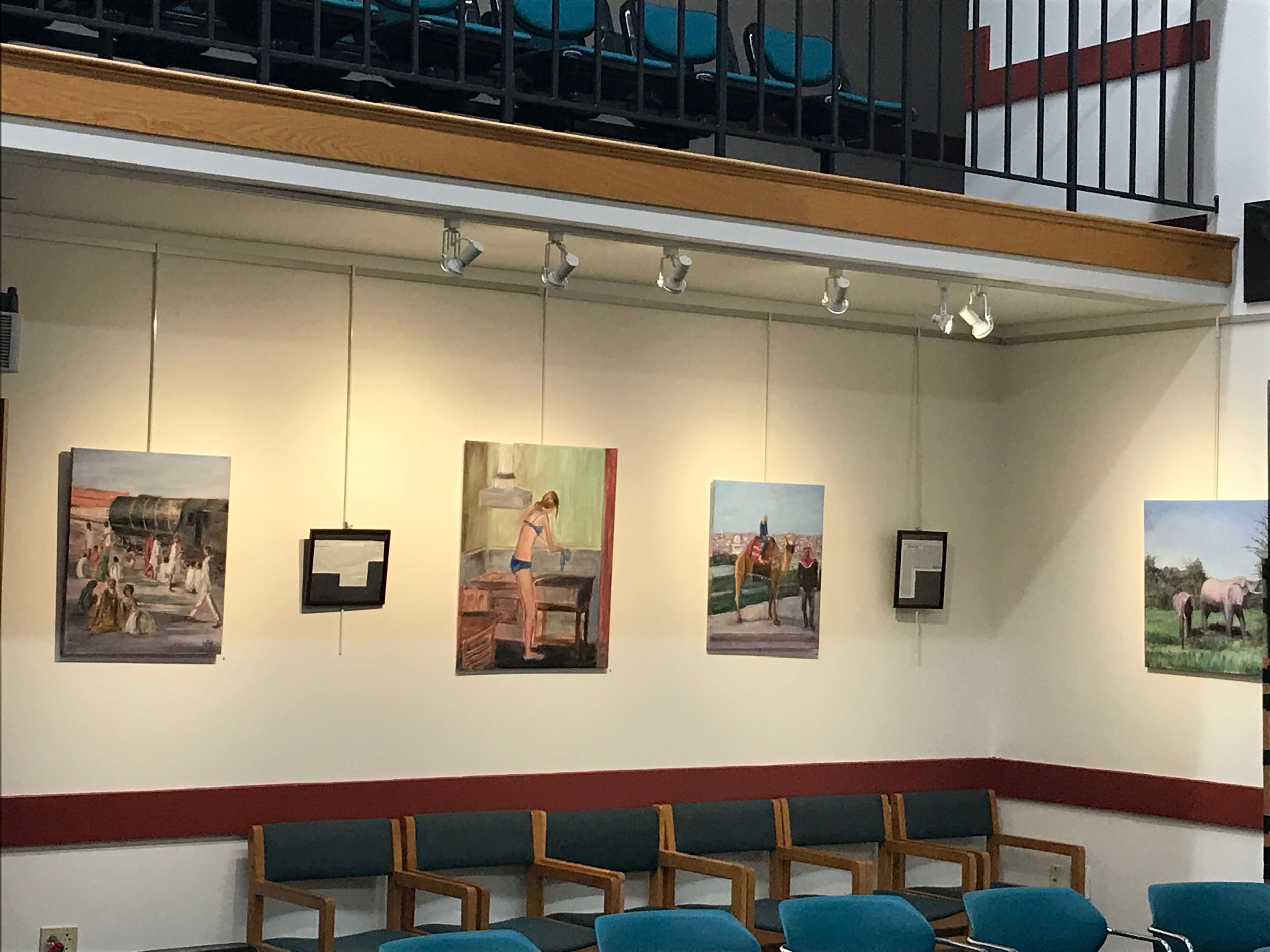Interview
Jennifer Stratton
Jennifer Stratton is a visual artist and expressive/creative arts educator. She is also a musician and does face painting on the side. She lives with her husband in Hyannis, MA. Jennifer began drawing and painting at a very young age and took private and group lessons from various New Jersey artists. She received the Art Prize upon graduating from high school but contrary to the expectations of her family and friends went on to study organic agriculture at college. Her studies brought her overseas, where she lived and worked in Papua New Guinea, Israel, and Brazil. Back in the United States, some personal challenges brought about a reconnection with art. Her new approach to artistic expression reflected a deeper connection to herself and the life force around her, manifesting in a unique, expressive style. She began to exhibit her work publicly in 1998 and has sold many paintings since then. Jennifer’s experience with the healing powers of expressive art developed into a strong desire to help others tune in to their own creative gifts.
In 2009, she received her Certificate of Graduate Studies for the Professional Application of Expressive Arts for Healing at Salve Regina University in Newport, R.I Since then, she has been working with different organizations, groups and individuals using expressive arts as a way for people to deepen their own connection to their creativity.
What is your background and how did you start your journey in the art world?
“I began drawing and painting as a child, studying with several established Tri-State Area artists. My high school awarded me the coveted Art Prize at graduation but, contrary to the expectations of my family and friends, I chose to study organic agriculture at college. My studies brought me overseas, where I lived and worked in Papua New Guinea, Israel, and Brazil. Back home, some personal challenges resulted in a reconnection with my earlier passion. I realized that art can heal at a deep level. My new approach to artistic expression reflected a deeper connection to myself and the life force around me, manifesting in a uniquely expressive style. I understood a desire to express my individual vision and at the same time to help others discover healing and empowerment through the arts. I completed a graduate program in the Expressive Arts at Salve University in Newport, Rhode Island. Since then, I have continuously taught and lead creative groups in a variety of settings, while continuing my own creative pursuits in my home studio. This balance is very important to me.”
What inspires you?
“I am inspired by nature, people, and emotions that are difficult to put into words. I find inspiration in dreams and ideas that come to me during the day; I can be just as energized by an inner feeling or idea as I can by something I see in front of me. Inspiration can be sudden or it can be a slow process, arising in its own time. When I was ten years old, my family took a year-long trip around the world. Just three years ago, the impact that trip had on my life finally gave rise to a powerful urge to capture it on canvas. I continue working on that series today.”
What themes do you pursue? Is there an underlying message in your work?
“I love using the natural world and human connection as my muses. Color and free flowing lines are important to me and how darkness and light play into whatever I’m working on. Both metaphorically and realistically.”
“I am inspired by nature, people, and emotions that are difficult to put into words.”
How would you describe your work?
“My work ranges from a free and expressive style to more carefully observed and realistic renderings. I go back and forth. For the past few years I’ve been focusing on my “Around the World” series. I’ve been using old photos and my memories to recreate experiences from my trip. These have been more carefully observed more realistic renderings. I am now looking forward to doing more free and expressive work. This usually begins with my own ideas and visions. I then try to capture the essence of these ideas on to canvas.”
Which artists influence you most?
“I have and will continue to be influenced by many artists from the past to the present. I was introduced to Matisse by my high school art teacher. My senior project, a three-part mural, was based on Matisse’s famous work, “Dance.” Matisse’s paintings and collages, and his expressive use of color and fluid lines, inspire and inform my ideas about art to this day.”
What is your creative process like?
“As a child, creativity was instinctual, an extension of who I was. It was joyful, fun, and a way to process and connect my inner and outer worlds. Then, as a teenager, art somewhat devolved into a material goal; there were skills to learn, judgements to be made, futures discussed. The joy began to seep out. I put a hold on that part of my life until my later twenties, at which time my visual art process came back to me as a way out of some dark times. It became part of my inner healing, a way to reconnect with my more authentic self. Now, art and creativity are a multifaceted experience for me: a mix of childlike joy and a way to make sense of a complex world. My work ranges from a free and expressive style to a more observant realistic approach. I have found fulfillment through both personal creativity and also by bringing creative opportunities to others, helping others discover themselves through art. Art has become a sacred pathway and a transformative journey for me.”
What is an artist’s role in society and how do you see that evolving?
“I once read about an anthropologist who visited an indigenous tribe in South America. He wanted to meet the artists and crafts people but the tribe’s leader said there were no members who held that job; everyone in the tribe participated in the arts. It was interwoven in their society. Our society is more compartmentalized. I you want to be an artist, you study art, if you want to be a musician, you study music, etc. I believe we have lost the thread of creativity as a communal, cultural experience. Artists play an important part in keeping the idea of expression and creativity alive. They set the pace for our culture. Artists bring to life non-linear ways of being in the world and help people connect with each other on a different level. Quite often the arts can raise people’s consciousness and awareness and lift spirits in a way that everyday life cannot. It’s difficult being an artist in the world. On one hand I feel it is important for everyone to experience the arts. It should be there for each and every one of us. But trying to make a living at it is a whole different story. Do I want to be recognized? Yes. Make money as an artist? Yes. But I also don’t want to lose my authentic self in the process. It can be difficult balancing the two.”
Have you had any noteworthy exhibitions you'd like to share?
“Showing my work is important to me and I’ve had many chances to host exhibits. My current show is called “Around the World in 1971.” This is a visual memoir of an excursion I enjoyed when I was ten years old, circumnavigating the globe with my parents and siblings. This year-long journey changed my life and I wanted to capture it on canvas. The trip was documented in photos and slides, which I used as models and for inspiration to create a series of paintings in acrylic and oil. A companion book, with photos and brief descriptions of the work, is included. The exhibit also features copies of articles my mother published in our local newspaper about our experience. I’ve presented the exhibit twice so far, on Cape Cod. Both were well-attended, successful events. I include a presentation and discussion about the trip and my inspiration and creative process. The shows were cathartic, reminding me once again how powerful art can be for both the artist and viewer.”
Website: www.jenniferstrattonart.com
Instagram: @jennifer.stratton.526
Brush Bio: www.brush.bio/jenji61-at-yahoocom





